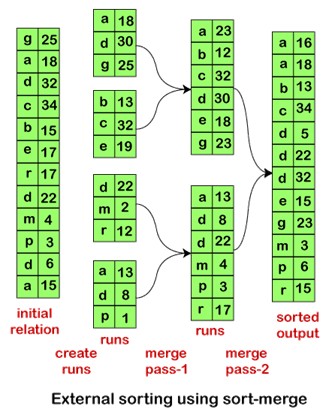Merge Sort is one of the most popular sorting algorithms that is based on the principle of Divide and Conquer Algoritm .
- Merge sort is similar to the quick sort algorithm as it uses the divide and conquer approach to sort the elements.
- It is one of the most popular and efficient sorting algorithm.
- It divides the given list into two equal halves, calls itself for the two halves and then merges the two sorted halves.
- We have to define the merge() function to perform the merging.
Here, a problem is divided into multiple sub-problems. Each sub-problem is solved individually. Finally, sub-problems are combined to form the final solution.
If q is the half-way point between p and r, then we can split the subarray A[p..r] into two arrays A[p..q] and A[q+1, r].
In the conquer step, we try to sort both the subarrays A[p..q] and A[q+1, r]. If we haven't yet reached the base case, we again divide both these subarrays and try to sort them.
When the conquer step reaches the base step and we get two sorted subarrays A[p..q] and A[q+1, r] for array A[p..r], we combine the results by creating a sorted array A[p..r] from two sorted subarrays A[p..q] and A[q+1, r].
MERGE_SORT(arr, beg, end)
if beg < end
set mid = (beg + end)/2
MERGE_SORT(arr, beg, mid)
MERGE_SORT(arr, mid + 1, end)
MERGE (arr, beg, mid, end)
end of if
END MERGE_SORT

To understand the working of the merge sort algorithm, let's take an unsorted array.
According to the merge sort, first divide the given array into two equal halves. Merge sort keeps dividing the list into equal parts until it cannot be further divided.
-
As there are eight elements in the given array, so it is divided into two arrays of size 4.
-
Now, again divide these two arrays into halves. As they are of size 4, so divide them into new arrays of size 2.
-
Now, again divide these arrays to get the atomic value that cannot be further divided.
-
Now, combine them in the same manner they were broken.
In combining, first compare the element of each array and then combine them into another array in sorted order.
- So, first compare 12 and 31, both are in sorted positions.
- Then compare 25 and 8, and in the list of two values, put 8 first followed by 25.
- Then compare 32 and 17, sort them and put 17 first followed by 32. After that, compare 40 and 42, and place them sequentially.
In the next iteration of combining, now compare the arrays with two data values and merge them into an array of found values in sorted order.
*Now, there is a final merging of the arrays. After the final merging of above arrays, the array will look like -

// Merge sort in C++
#include <iostream>
using namespace std;
// Merge two subarrays L and M into arr
void merge(int arr[], int p, int q, int r) {
// Create L ← A[p..q] and M ← A[q+1..r]
int n1 = q - p + 1;
int n2 = r - q;
int L[n1], M[n2];
for (int i = 0; i < n1; i++)
L[i] = arr[p + i];
for (int j = 0; j < n2; j++)
M[j] = arr[q + 1 + j];
// Maintain current index of sub-arrays and main array
int i, j, k;
i = 0;
j = 0;
k = p;
// Until we reach either end of either L or M, pick larger among
// elements L and M and place them in the correct position at A[p..r]
while (i < n1 && j < n2) {
if (L[i] <= M[j]) {
arr[k] = L[i];
i++;
} else {
arr[k] = M[j];
j++;
}
k++;
}
// When we run out of elements in either L or M,
// pick up the remaining elements and put in A[p..r]
while (i < n1) {
arr[k] = L[i];
i++;
k++;
}
while (j < n2) {
arr[k] = M[j];
j++;
k++;
}
}
// Divide the array into two subarrays, sort them and merge them
void mergeSort(int arr[], int l, int r) {
if (l < r) {
// m is the point where the array is divided into two subarrays
int m = l + (r - l) / 2;
mergeSort(arr, l, m);
mergeSort(arr, m + 1, r);
// Merge the sorted subarrays
merge(arr, l, m, r);
}
}
// Print the array
void printArray(int arr[], int size) {
for (int i = 0; i < size; i++)
cout << arr[i] << " ";
cout << endl;
}
// Driver program
int main() {
int arr[] = {6, 5, 12, 10, 9, 1};
int size = sizeof(arr) / sizeof(arr[0]);
mergeSort(arr, 0, size - 1);
cout << "Sorted array: \n";
printArray(arr, size);
return 0;
}
| Case | Time Complexity |
|---|---|
| Best Case | O(n*logn) |
| Average Case | O(n*logn) |
| Worst Case | O(n*logn) |
| Space Complexity | O(n) |
|---|---|
| Stable | Yes |
The space complexity of merge sort is O(n). It is because, in merge sort, an extra variable is required for swapping.










